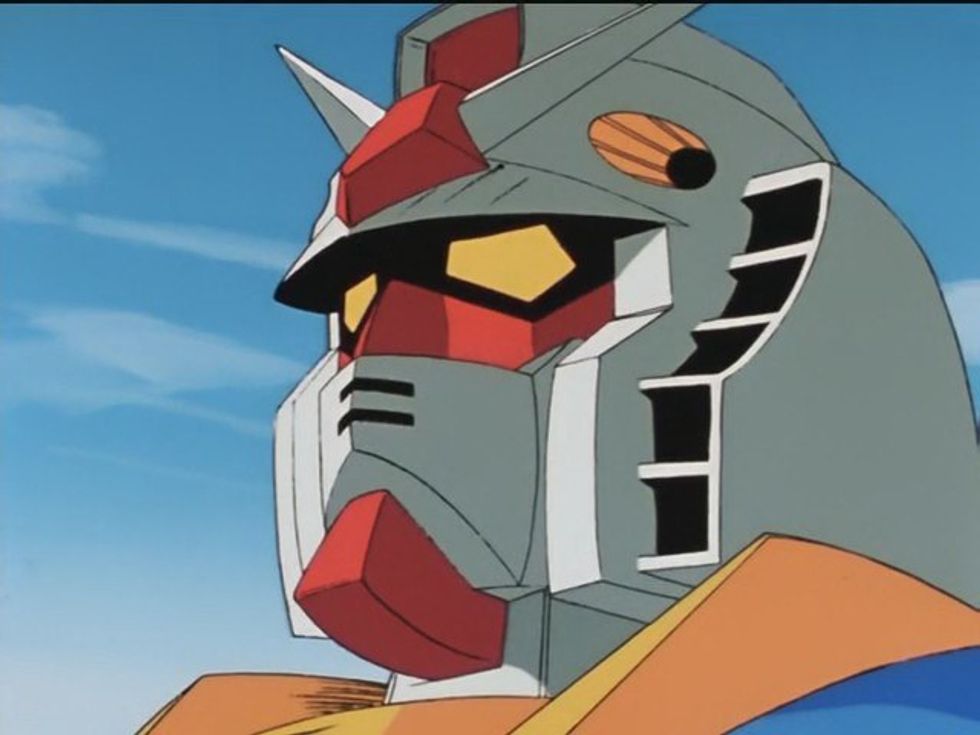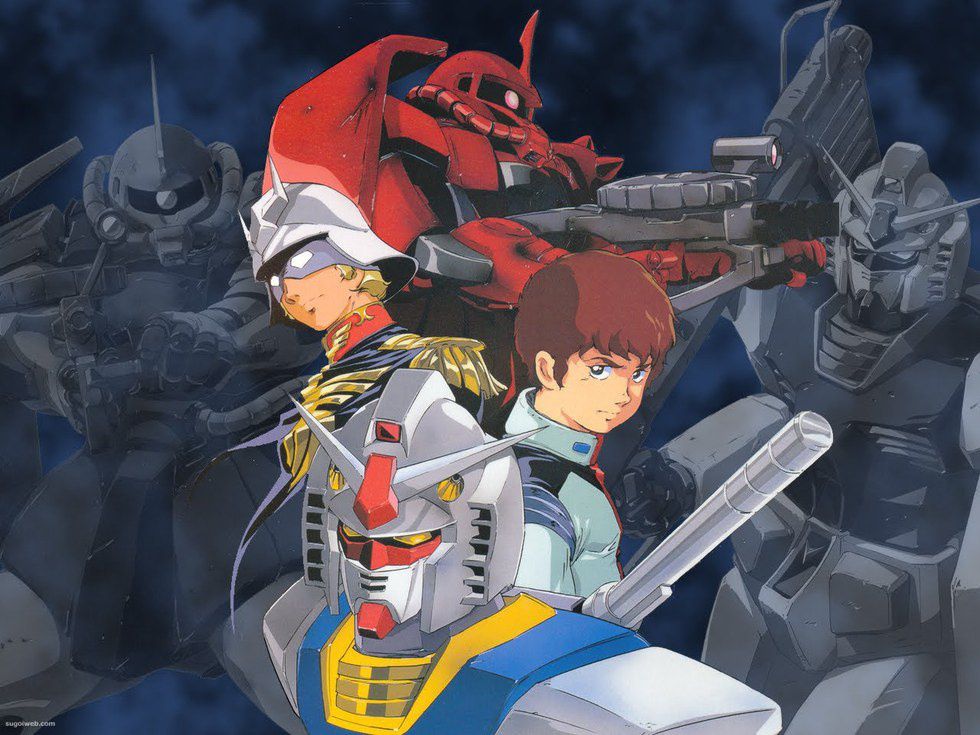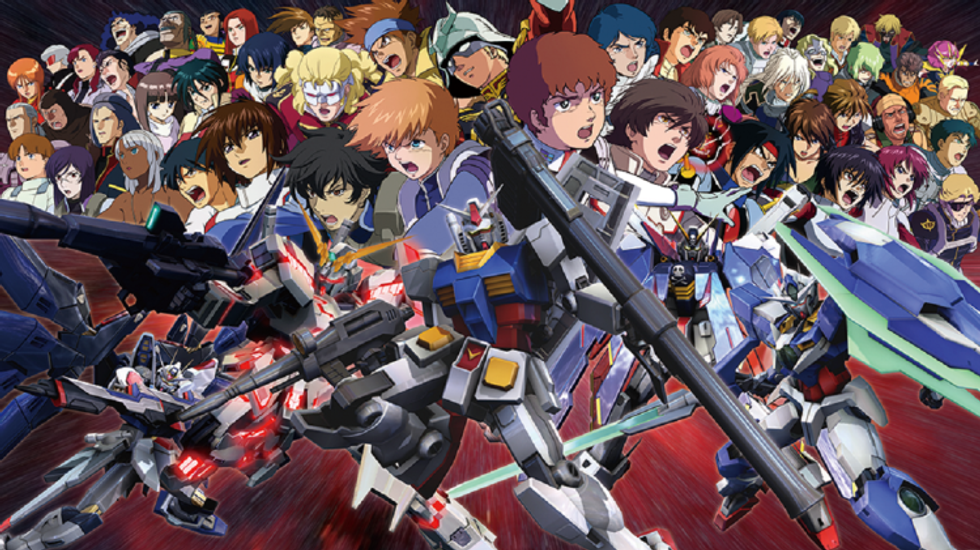In the vacuum of space, a pilot curses her controls in a dark cockpit lit only video monitors. The entire world is shaking. The monitors fill with fire and weapons fire as she manipulates the controls to avoid certain death. Swarming in tandem are armed humanoid armors called mobile suits. They fly in formation in the no man’s land between space fleets comprised of massive carriers and battleships that reign fire upon the battlefield. These space cruisers hold friends and significant others. They carry the hope of the future of the war they are fighting. The pilots lament as they charge forward, leaving their loved ones behind, engaging in the greatest conflict in mankind’s history: the humans of space vs. the humans of earth.
This is the essence of the world of Mobile Suit Gundam. It is a monumental piece of influential animation, both as a work of engrossing story and as a forerunner of anime. Nothing short of a cultural legend in Japan, here the states, Gundam enjoys a decent, though underwhelming popularity. The series has spawned multiple sequels, spin-offs, mangas, and movies. Gundam series feature webs of characters and factions whose fates hang ever in the balance ala Game of Thrones. Sometimes the good die, the “bad” guys win, and other times everything goes wrong. Gundam is a space opera, featuring love, tragedy, betrayal and coming of age stories rolled into explosive action. It features fleet battles, mobile suit squad battles and duels, sword fights and tense gun on foot skirmishes. Through all of this the series ultimately delivers a powerful message on war and conflict.It all started with the original Mobile Suit Gundam. The now legendary Yoshiyuki Tomino, who wanted viewers to experience the senselessness of war created the show under producers Sunrise in 1979. The show follows the exploits of Amuro Ray, who pilots the very first Gundam, and his comrades during the war of independence between the Earth Federation and the Principality of Zeon.
When Gundam was released, it was a completely new concept that challenged the current state sci-fi action stories in Japan. At the time, anime involving giant robot revolved around entirely competent heroes who possessed indestructible robots with unbeatable power fighting against representations of universal evil. Gundam revolutionized all that.
This show introduced concepts of realistic limitations to weaponry like durability and ammo, as well as less than proficient pilots of the mobile suits that have become the mainstay weapons of war in this future timeline. Characters needed to become cunning strategists, and develop their skills with ever advancing technology to survive. The character's robots could explode because of malfunctions, and gunshot wounds carried far more weight than in the average anime. Mobile Suits are varied and diverse, and have real limitations.
The central conflict of Mobile Suit Gundam is a sobering and realistic conflict between space colonists and the government of the Earth. Far into the future, mankind has taken to the stars in giant orbiting space colonies referred to as Sides. These colonies replicate life on earth, and push humanity to develop further and faster to adapt to life in space.
Almost a century since the first colony launched has passed, and in the year 0079 of the Universal Century, the corrupt Earth Government has allowed the rise of the Zabi family, who quickly usurp power in the space colony furthest from the Earth and declare war on the entire Earth’s Sphere. The original conflict becomes a twisted devolution of its original principles of autonomy and independence as the Zabi family install a dictatorship known as the Principality of Zeon while proclaiming humans of space to be a superior and chosen race.
The war ignites, and the Zeon introduce radar-jamming particles rendering long-range weaponry like tactical missiles and drones useless. At the same time, they develop the mobile suit: massive humanoid armored robots controlled from a cockpit in the torso. These quickly take center stage in the battles in space. After just six months, the Principality of Zeon gasses a space colony and drops it on earth, killing millions of people. At the beginning of the original series, the war is at a stalemate. Known forever after as the One Year War, these two sides demolish half of humanity’s population in just six months of fighting.
The game changer is the Gundam: A mobile suit superior to all other models at the time that bears the now iconic faceplate and color scheme.
The fifteen year old protagonist Amuro Ray finds himself in the cockpit of this powerful machine and so begins the narrative of the spacecraft White Base, an irregular crew of young civilians forced to man the battleship for their very survival.
The heroes of the story are three-dimensional and develop as each comes into their own over the course of the war. The captain of the White Base, Bright Noa, is a regular soldier who now is charged with mentoring and guiding the civilians through combat and molding them into their own crew. Amuro, the main protagonist has a few different love interests who each have their own back-stories. Viewers also experience Amuro’s coming of age as a brave pilot hero of the federation. His trials and tribulations bring him from turbulent, headstrong teenager, to fore thinking, experienced warrior. The Gundam can be viewed as metaphor for the power of manhood, as Amuro struggles to come to grips with the responsibility of wielding the power of the Gundam.
The Zabi family, who lead the Zeon forces, are the epitome of a treacherous royal family, each with their own hidden motives, agendas, and ideas about how the war should be handled. They all strive to out manuver one another for power as their family is slowly dismantled through their own conceit and the workings of an outsider plotting their demise.
The characters are pushed and pulled by the events of the war and respond exactly how humans should and do: irrationally. Romances form, friendships are broken, vengeance is taken, and loved ones are lost as the war careens toward its end. Humans are flawed, and such are the arcs of each of the characters that make up the cast of Gundam.
Another piece of Gundam's enduring legacy is the action. While its central focus is its characters, the mobile suit combat keeps viewers on their toes. You can feel the urgency as the pilot scrambles to maneuver his machine out of harm's way or to reload his weapon before he becomes surrounded. The show features set piece action that spans combat during atmospheric reentry, to the surface of asteroids, to the jungles of the pacific. The action doesn't only include mobile suit battles either.
Perhaps the most poignant aspect of Gundam is it brilliant theme. War is illustrated as a careless monster. The conflict is always shown in shades of grey. Both sides of the conflict are guilty of crimes, dishonesty, corruption and violence. Within the swirling tide of conflict, we see endearing human drama develop, only to have it cast aside by the illogicality of war. The director of Gundam, Tomino, gained the moniker “Kill ‘Em All” through his work on several Gundam series, and his penchant for killing off prominent characters is on display here. While this makes for suspenseful viewing, many character deaths are tragic, displaying character arcs that are never resolved. This, along with the struggles of those who survive, illustrates how violence resolves nothing. The conflicts, both personal and political end up feeling true to reality. It is all the more grasping when the viewer grasps the ultimate damage of the war.
Thankfully, amongst the more depressing messages is ultimately one of hope and compassion. The idea of a “newtype” or evolved human is a concept unique to Gundam. Newtypes are explained easily as psychics, but they are more than that. They are the result of humans living in outer space and evolving to the next stage. A primary aspect of these sensitive people is limited precognition. They can sense other psychic power, or see the next move an opponent is going to make. They also possess an ability to immediately empathize with one another. This is held to be their most powerful trait, and the defining feature of newtypes. Gundam teaches us that war is horrific and wrong, while the ultimate evolution of humankind is compassion and understanding.
Within this contrast we can see Gundam’s arguent crystallize. Never before had an action television show went to such pains to express the lack of good and bad sides in war while ultimately showing it to be wrong and proclaiming empathy to be the higher power.
Another huge highlight of the series is the penultimate anime rivalry. This is that of Amuro Ray and Char Aznable, the Red Comet. Most cartoon and anime fans will be familiar with the concept of a protagonist and deuteragonist playing off each other as rivals throughout the series, but back in 1979 it wasn’t found in most stories. Char is an ace pilot in the Zeon forces, piloting a bright red mobile suit and renowned throughout both militaries. He faces off against Amuro repeatedly until Amuro’s skills finally surpass his own. Char’s character is perhaps the most fascinating of all the characters, as his motives are truly his own. Assuming a stolen identity to conceal his mysterious past, he infiltrated the Zeon Military to exact revenge on the Zabi family. His quest will take him from antagonist to the cusp of becoming an anti-hero, all while tangling with Amuro in tense mobile suit duels.
The original Mobile Suit Gundam is one of the finest sci-fi sagas ever produced for watching and reading (there’s a manga). It is severely underrated as an influence on popular culture and is well worth a watch simply for the entertainment value.
Gundam is full of intriguing concepts and engrossing characters, while supplying all the action one could hope for in a fifty-episode run. Beyond the original series, there is a wealth of other content to devour. The original timeline has spawned nine other productions set in the same history. This gives fans a chance to follow characters like Amuro and Char across multiple seasons. These two characters in particular play off each other for two series and a movie where they fight for the fate of the Earth. Continuing the story also offers thirty years of mobile suit development to track, along with the escalating drama of several factions.
Even then, there are several alternate timelines each with their own self-contained story and even more mangas, video games, and novels. Altogether there are 28 shows to view. There is an almost endless stream of content available to those who’ve enjoyed the story. Once you've stepped into the Gundam universe, there is an obscene amount to enjoy.
In short, Gundam is a space epic relevant to the times and endlessly entertaining as a piece of pop culture. It can be enjoyed as a retro piece of fun, an influential predecessor to many of the tropes we enjoy today, or simply a damn good show. As with all anime, dubbings contain mistranslations and for western audience some scenes may feel like they have too much melodrama. The original also sports dated animation. The series as a whole is an engrossing and emotional experience that pays off in character development, varied action and world building.
Go find a piece of Gundam lore and enjoy its fast paced action combat and brimming world of characters you’ll love to hate and hate to love. At the end of the day, let its message penetrate. That war is the sum total of all our evil, and we should aspire to understand one another.






















